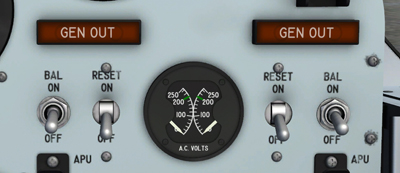
The ballistic control system switches, above the APU switches.
At the time of publication, ballistic control for rocket airplanes was still not supported in either Microsoft® Flight Simulator X or Lockheed Martin® Prepar3D®. Consequently, the BCS and RAS controls and switches in the X-15A-2 SE do not perform any simulator function in this software version, other than being animated to simulate BCS and RAS-related procedures. The ballistic control stick [8, fig. 5-4] in the virtual cockpit follows the movement of the center stick [8, fig. 4-1] to simulate BCS operation at high altitude.
The No. 1 and No. 2 ballistic control switches [18 and 27, fig. 5-1], on the instrument panel, are powered by the primary DC bus.
Moving either switch to ON simultaneously opens the helium shutoff valve and the propellant feed system jettison and ballistic control valve for the respective system and allows hydrogen peroxide to flow to the metering valves. With either switch at OFF, the propellant feed system jettison and ballistic control valve for the respective system is turned off. However, the helium shutoff valve will not close as long as either APU switch [17 or 30, fig. 5-1] is at ON.
Note: When either APU switch is at JETT, the feed system jettison and ballistic control valve for the related system of the ballistic controls closes and shuts down that system.
The ballistic control stick [8, fig. 5-4], above the left console, is mechanically connected to the system metering valves. When the ballistic control system is operating, moving the stick positions the metering valves to allow flow of hydrogen peroxide to the selected rockets in the nose and wings.
Yaw control is obtained by direct left or right movement of the stick. For left yaw, the stick must be moved directly to the left.
Roll control is obtained by rotation of the stick. For left roll, the stick must be rotated to the left (counterclockwise).
Pitch control is obtained by direct up or down movement of the stick. An airplane nose-up pitch change is obtained by raising the stick.
Note: Clicking the ballistic control stick handle in the virtual cockpit disables the center stick [8, fig. 4-1] and the right console stick [3, fig. 5-5] and enables the ballistic control stick. The ballistic control stick is disabled by default.
The nose ballistic rocket heater switch [34, figure 5-1], on the instrument panel right-hand wing, receives electrical power from the carrier airplane. Moving this switch to ON during captive flight starts the electric heaters on the ballistic control system rockets in the nose of the X-15 to preheat the rockets. After launch, this switch is inoperative.